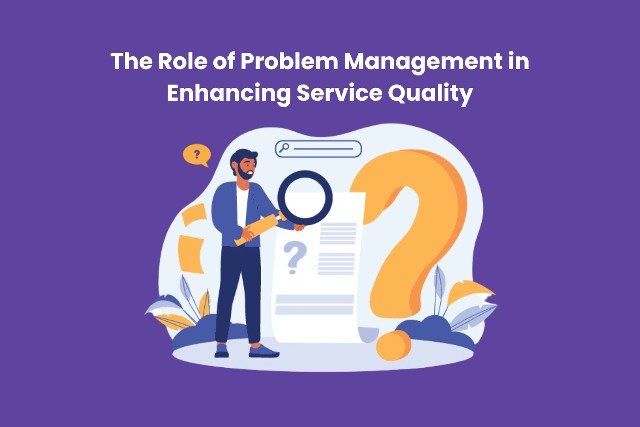Knowing the importance of Problem Management is a critical first step in becoming an excellent provider of IT services. In this blog, we will explore the vital role this discipline plays in raising the quality of IT services, whether you’re taking an ITIL Course or want to improve your understanding of ITIL Problem Management.
Table of Contents
- The Basics of ITIL Problem Management
- What is ITIL Problem Management?
- Why is ITIL Problem Management Crucial?
- Minimising Service Disruptions
- Enhancing Customer Satisfaction
- Optimising Resource Utilisation
- Continuous Improvement
- Integration with ITIL Framework
- Challenges in Implementing ITIL Problem Management
- Complexity of IT Environments
- Resistance to Change
- Data and Information Management
- Resource Allocation
- Continuous Monitoring and Improvement
- Best Practices for ITIL Problem Management
- Training and Skill Development
- Robust Documentation
- Collaboration and Communication
- Change Management
- Data Analytics and Reporting
- Prioritisation
- Continuous Improvement
- Conclusion
The Basics of ITIL Problem Management
ITIL (Information Technology Infrastructure Library) is the industry standard for IT service management. ITIL provides a set of best practices for providing top-notch IT services. ITIL Problem Management is one of this framework’s main components.
What is ITIL Problem Management?
The proactive method of identifying and fixing the underlying causes of recurrent problems is known as ITIL Problem Management. It extends beyond band-aid solutions and reactive actions, with the ultimate goal of preventing problems from happening again and raising the quality of services provided. Organisations may guarantee more seamless operations and satisfied customers by looking into and fixing the root causes.
Why is ITIL Problem Management Crucial?
IT services are the foundation of most enterprises in today’s technologically advanced society. Delays, interruptions, or inefficiencies may significantly impact customer happiness and productivity. ITIL Problem Management may help in this situation.
Let’s examine the reasons it matters:
Minimising Service Disruptions
The capacity of ITIL Problem Management to minimise service interruptions is one of its main advantages. IT teams may stop incidents from happening in the first place by figuring out and fixing the underlying causes of the problems. Increased dependability, less downtime, and better service continuity are the outcomes of this proactive strategy.
Enhancing Customer Satisfaction
Clients anticipate flawless IT support. Organisations may satisfy these expectations by continually providing dependable and effective services, which is made possible by ITIL Problem Management. Higher levels of client satisfaction and loyalty result from this, and these are essential in the cutthroat business environment of today.
Optimising Resource Utilisation
In IT service management, efficiency and resource optimisation are essential objectives. In order to prevent IT resources from being squandered on recurring incident resolution, ITIL Problem Management helps with this. Alternatively, these resources might be used for corporate growth-promoting strategic projects.
Continuous Improvement
Continuous improvement is directly related to ITIL Problem Management. IT teams may improve and adjust their procedures over time by examining reoccurring issues and pinpointing opportunities for improvement. As a result, service quality continues to improve.
Integration with ITIL Framework
The ITIL Processes of Incident Management, Change Management, and Service Level Management are all easily integrated with ITIL Problem Management. By using an integrated approach, issues are prevented from becoming isolated episodes and instead become a part of a larger plan for service development.
Challenges in Implementing ITIL Problem Management
ITIL Problem Management has many benefits, but there are some obstacles to overcome when putting it into practice. Let’s investigate these obstacles:
Complexity of IT Environments
Contemporary IT infrastructures have many interdependencies and can be complicated. It might be difficult to identify and fix the core causes of problems in such complex systems. Professional staff and cutting-edge equipment are necessary to properly negotiate this intricacy.
Resistance to Change
Presenting ITIL An organisation’s culture may need to change for Problem Management to work. Certain team members can object to new protocols. To overcome this resistance, effective communication and Change Management techniques are essential.
Data and Information Management
ITIL Problem Management is primarily dependent on information and data. Reliable and current documentation is essential for issue-solving and decision-making. The procedure might be hampered by improper data handling.
Resource Allocation
An organisation’s budget may be strained when staff, equipment, and technology are allocated to Problem Management. One of the main challenges is balancing these expenditures with other IT activities.
Continuous Monitoring and Improvement
Problem Management calls for constant observation and development; it is not a one-time endeavour. It might be difficult to sustain this dedication, but long-term success depends on it.
Best Practices for ITIL Problem Management
Take into account the following recommended practices to overcome these obstacles and maximise ITIL Problem Management:
Training and Skill Development
Invest in your IT team’s education and skill-building. Give them the skills and resources they need to manage problems successfully. To guarantee that your workforce is knowledgeable about best practices, think about taking an ITIL course.
Robust Documentation
Keep an accurate and thorough record of all incidences and issues. The cornerstone of efficient Problem Management is this paperwork.
Collaboration and Communication
Encourage team members to work together and communicate honestly. This guarantees that issues are found and fixed more quickly.
Change Management
To make the switch to ITIL Problem Management easier, put in place a strong Change Management procedure. Overcoming opposition requires assistance and transparent communication.
Data Analytics and Reporting
Use reporting and data analytics tools to find patterns and persistent issues. You may use these insights to direct your problem-solving efforts.
Prioritisation
Not every issue is equally important. Sort them into priority lists according to how they affect company operations and service quality. This enables you to manage your resources effectively.
Continuous Improvement
Establish a culture of ongoing development for your IT staff. Review and improve your problem-solving procedures on a regular basis.
Conclusion
Providing top-notch IT services requires a foundational understanding of ITIL Problem Management. Even while implementation may provide some difficulties, there are significant advantages. By adopting best practices and making a commitment to continuous improvement, businesses may improve the quality of their services and provide clients with a more dependable and effective experience.
Introducing ITIL Problem Management into IT service delivery is a proactive step in the right direction. Recall that the goal of an ITIL course or further exploration of this practice is ongoing improvement and customer satisfaction.


